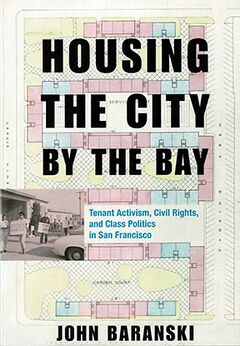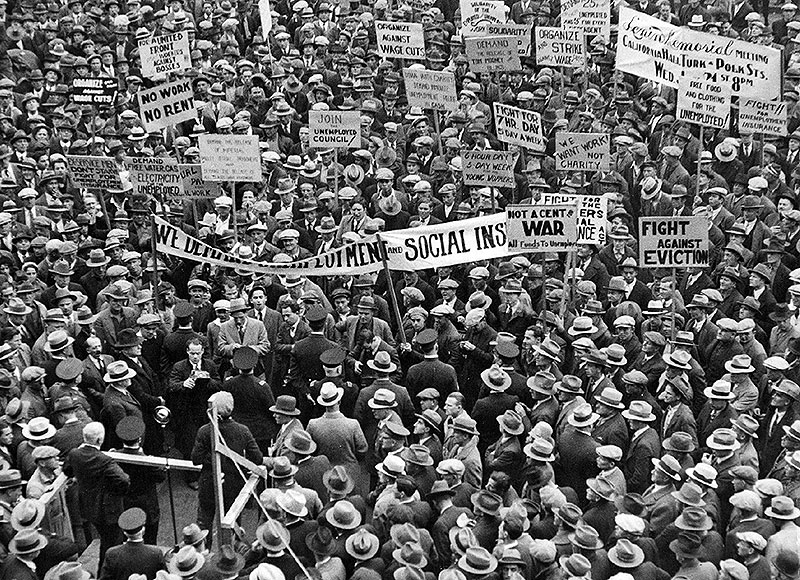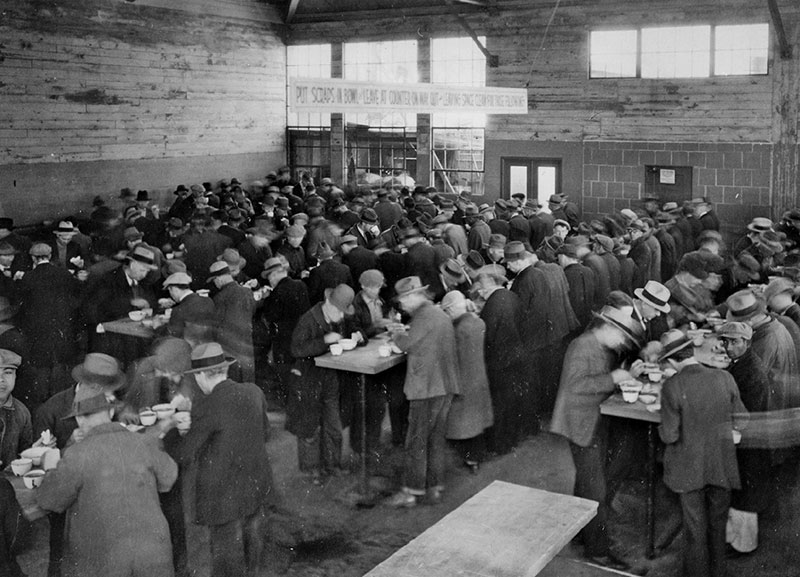Housing Crisis Worsens at Start of Depression
Historical Essay
by John Baranski
This excerpt originally appeared in "Progressive Era Housing Reform," Chapter One of Housing the City by the Bay: Tenant Activism, Civil Rights, and Class Politics in San Francisco (see below for copyright and book information)
San Francisco residents protest for economic security and rights in 1931.
Photo: San Francisco History Center, SF Public Library
The unresolved problems in the housing sector contributed to the Great Depression but also reinvigorated interest in housing reform. In the early years of the crisis, home construction plummeted, and foreclosures of non-farm homes skyrocketed. Housing insecurity added to the stress of families already suffering from unemployment and underemployment. In 1931, Herbert Hoover, by then U.S. president, sponsored the White House Conference on Home Building and Home Ownership, though he remained committed to private sector solutions even after several years of industry failure. At the conference, according to housing and social reformer Loula Lasker, Hoover “urged upon the hundreds of delegates present—architects, city planners, social workers, et al.—to push home-ownership, dramatically inferring that only in his own little home could a real American be happy.” Researchers presented reports on the social and economic implications of a failed housing sector, including an entire volume on how discrimination and housing shortages compounded the problems of African Americans.(52)
Despite Hoover’s pitch for private sector solutions, the conference participants produced a list of policy proposals that included government-secured home loans, slum clearance coupled with a vigorous public housing program, limited-dividend and cooperative housing developments, and neighborhood planning initiatives. Of these recommendations, Hoover supported two: the Federal Home Loan Bank Act of 1932, which provided both credit and capital for mortgage lenders, and the Emergency Relief and Construction Act of 1932, which created the Reconstruction Finance Corporation, a body that made loans to limited-dividend corporations for constructing low-income housing. Both pieces of legislation, however, had so many strings attached that few applications were approved.(53) Still, the national-level discussion of government alternatives to privately built and owned housing, and the federal policies themselves, signified an intellectual link to progressive housing reforms on both sides of the Atlantic and a slight shift in how best to use the federal government to improve the housing sector and house the nation.
Depression-era San Francisco faced housing and larger economic crises similar to those occurring across the country. In San Francisco, business failures produced unemployment and underemployment. Social unrest increased as public and private relief failed to meet demand. In 1931, more than a thousand demonstrators marched to City Hall under the Communist Party banner, and protests and mass assemblies became routine.(54) By the spring of 1932, the caseload of destitute families served by Katherine Felton’s Associated Charities had risen to 8,000 from pre-1929 levels of about 300. Daily she heard “familiar chronicles of disaster—jobs lost, savings wiped out, credit stopped at the corner grocery, furniture sold piece by piece, sickness, unpaid doctors’ bills, debt.” It was so bad that Felton changed the name of her organization to the Citizens’ Agency for Social Welfare because she wanted to eliminate the stigma associated with citizens receiving relief.(55)
Feeding San Francisco's unemployed in 1932.
Photo: San Francisco History Center, SF Public Library
San Francisco’s housing situation was grim, and the private housing market was suffering. San Francisco real estate agent Kernan Robson spoke of tight credit markets, growing slum conditions, and how his office was only selling lots “without street work, without gas, and even without sewers.”(56)
The deepening economic crisis affected the 1932 presidential election. Millions of people filled social halls and attended forums in urban and rural areas to de- bate the proper role of government in the economy. Housing reformers promoted government intervention in the housing sector as a means of both employing and housing people. In her Recent Trends in American Housing (1931), the distinguished housing expert Edith Wood highlighted the benefits government housing had brought to national economies in Europe, especially after World War I. She asked, “Can we not have vision enough to re-build our Devastated Regions without waiting for a war to destroy them?” She ended her book by writing: “Wanted: A Major Statesman to make Housing on the Grand Scale the chief plan in his platform.”(57) Hoover, however, remained reluctant to use federal power to address the housing and unemployment problems of ordinary citizens. His inaction contributed to the success of his opponent, Franklin Roosevelt, in the 1932 election.
The 1906 earthquake and fire, and the low-quality housing that followed in many city neighborhoods, inspired San Francisco reformers to focus their attention on the housing question. Nearly all of the city’s housing reformers were white elites with ties to reform organizations, business associations, and government agencies. Female housing reformers outnumbered men, yet the latter usually filled most of the leadership positions. Alice Griffith, Elizabeth Ashe, and Katherine Felton contributed to the formation of reform organizations that would be part of international housing reform discussions and efforts. These connections provided a wide range of ideas and legislation for improving the city’s housing. Through their knowledge and their organizations, San Francisco reformers acquired a degree of housing expertise that allowed them to work on local and state housing legislation, including the creation of the CCIH.
Importantly, San Francisco’s housing reformers proposed several different ways to use government to improve the city’s housing and built environment. Of their various policy proposals, their plans for public housing after the earthquake and limited-dividend and cooperative housing through the CCIH were the most ambitious in using government in new ways. But in San Francisco, as in other cities in the United States, the call for such alternatives to private housing did not take hold—because the reform communities failed to include the very workers they tried to house; because housing knowledge, such as that exhibited at world’s fairs, did not win over the public; and because the legitimacy of private property in law and political culture was too powerfully entrenched, especially outside of the housing reform community.
With limited public support, early government housing policies at the local and state level led to building codes, tenement laws, and zoning laws. But, as housing reformer Edith Wood noted at the time, such a regulatory policy “may forbid the bad house, but it does not provide a good one.”(58) Nor did these reforms have the power to help the home construction and finance industry during the early years of the Great Depression. As Franklin Roosevelt prepared to occupy the White House, housing reformers around the nation began to agitate and organize for federal housing legislation. With Roosevelt, housing reformers hoped that their statesman had arrived.
previous article • return to beginning
Notes
52. Loula Lasker “Uncle Sam—Landlord,” Survey Graphic (March 1934): 124–28, 141–42; quote on 124.
53. Report of the President’s Conference on Home Building and Home Ownership (1932); Jackson, Crabgrass Frontier, 192–95; Radford, Modern Housing, 85–89.
54. Issel and Cherny, San Francisco, 49–51.
55. Burton, Katherine Felton, 224–27, quote on 226.
56. Kernan Robson to Senator Huey Long (March 24, 1934), Folder 4500.09, Box 297 Project 4402, Project 4600, Project Files (1933–1937), RG 196, NARA/CP.
57. Wood, Recent Trends, 297.
58. Ibid., 11.

Excerpted from Housing the City by the Bay: Tenant Activism, Civil Rights, and Class Politics in San Francisco by John Baranski, published by Stanford University Press. Used by permission. © Copyright 2019 by John Baranski. All rights reserved.


